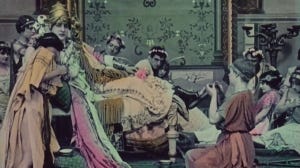A Roman Orgy | Cinema Year One
The day I began writing this essay, I spent the morning listening to Billie Eilish in my iTunes window, reading a book on Japanese film scholarship in the first half of the 20th century on a PDF for my dissertation, and intermittently checking off my daily tasks in my Notes app, before circling back to the Eilish album and cur…
Keep reading with a 7-day free trial
Subscribe to Cinema Year Zero to keep reading this post and get 7 days of free access to the full post archives.





